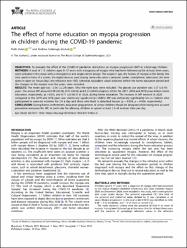The effect of home education on myopia progression in children during the COVID-19 pandemic
Abstract
Objectives: To evaluate the effect of the COVID-19 pandemic restrictions on myopia progression (MP) in school age children.
Methods: A total of 115 children aged 8–17 years with a diagnosis of myopia who had been followed-up for at least three years,
were included in this study with a retrospective and single-centre design. The subjects’ age, the history of myopia in the family, the
time spent in front of a screen, the digital devices used during home education (computer, tablet, smartphone, television), the time
spent in open air (hours/day), the refractive error (RE) (spherical equivalent value) detected before the home education period and
the changes in the myopia over the years, were recorded.
RESULTS: The mean age was 12.06 (±2.29) years. Only the right eyes were included. The glasses use duration was 3.57 (±0.74)
years. The annual MP amount 0.49 (±0.26), 0.41 (±0.36) and 0.54 (±0.43) dioptres (D) for the 2017, 2018 and 2019 years before home
education, respectively, (p > 0.05), and 0.71 (±0.46) D in 2020, during home education. The increase in MP amount in 2020
compared to the 2019 and 2018 years was statistically significant (p < 0.003). MP was statistically significantly less in children who
participated in open-air activities for 2 h a day and those who lived in detached houses (p = 0.004, p = 0.006, respectively).
Conclusion: During home confinement, education programmes of school children should be designed while taking into account
preventive measures for MP, in particular for allowing children to spend at least 2 h of outdoor time per day.


















